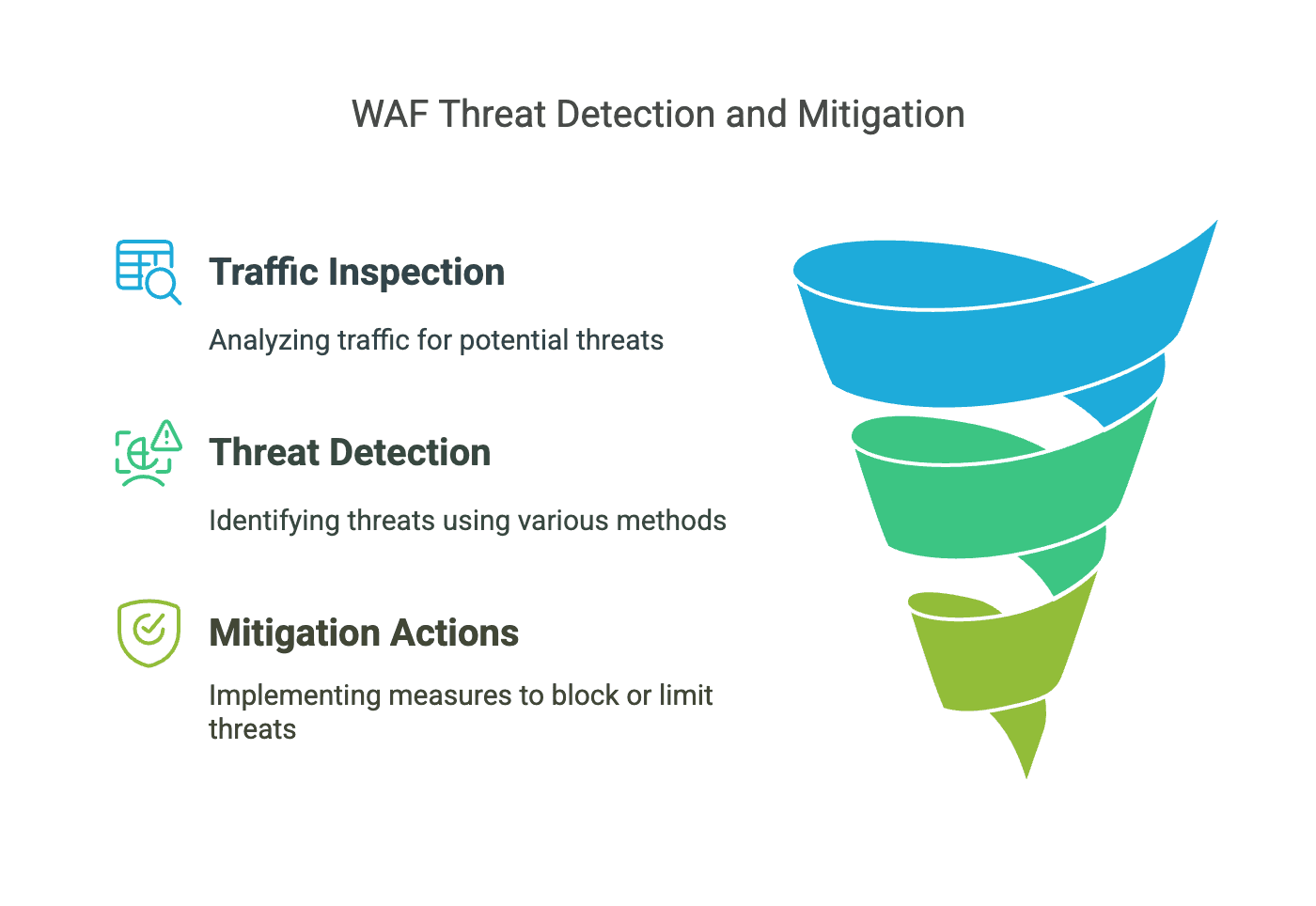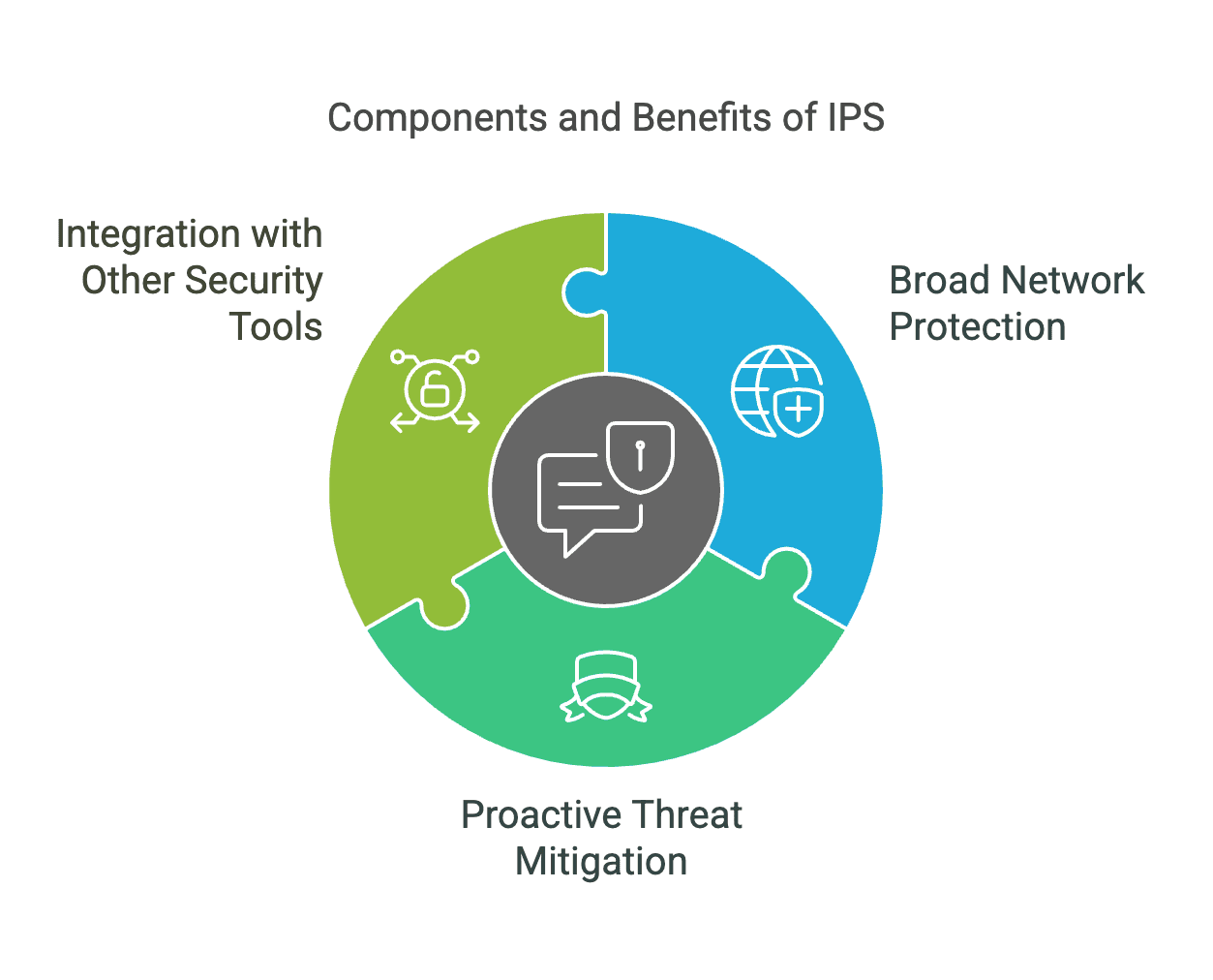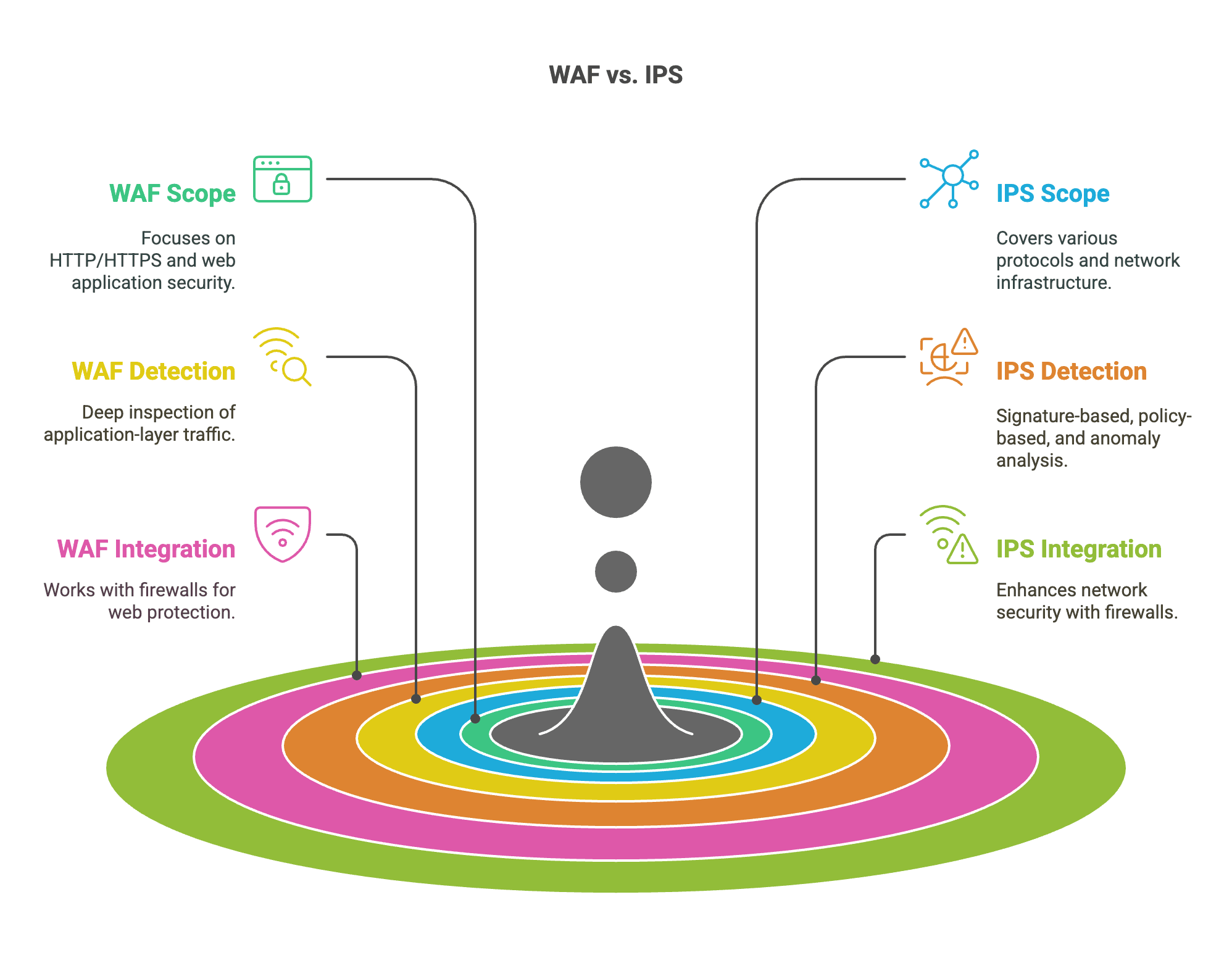In today's digital landscape, cybersecurity has become a critical concern for businesses and organizations of all sizes. As cyber threats continue to evolve and become more sophisticated, it is essential to deploy robust security solutions to protect valuable assets and data. Two commonly used security tools are Web Application Firewalls (WAF) and Intrusion Prevention Systems (IPS). Both are designed to detect and mitigate threats, but they serve different purposes and operate in distinct ways. This article aims to provide a comprehensive comparison between WAF and IPS, highlighting their unique functionalities, use cases, and how they can complement each other in a comprehensive cybersecurity strategy.
What are Web Application Firewalls (WAF)?
A Web Application Firewall (WAF) is a specialized security solution designed to protect web applications from a wide range of attacks. It acts as an intermediary between the web application and the user, analyzing HTTP traffic to detect and block malicious requests. Compared to traditional firewalls, WAFs are particularly effective at mitigating application-layer attacks such as Cross-Site Scripting (XSS), SQL Injection, and Distributed Denial of Service (DDoS) attacks. By inspecting incoming traffic at the application level, a WAF can identify and block suspicious activities that other security tools might miss.
Key features and benefits of WAF include:
- Protection Against Application-Layer Attacks: WAFs are specifically designed to protect web applications from targeted threats that exploit vulnerabilities in the application code.
- Minimal Disruption: By focusing on application traffic, WAFs can ensure that legitimate users can access the web application without significant delays or disruptions.
- Compliance and Reporting: Many WAF solutions offer detailed logging and reporting capabilities, which can help organizations meet regulatory compliance requirements.

Operational Mechanics
WAFs employ two primary security models: positive and negative. The positive security model allows only known good traffic based on predefined rules, while the negative security model blocks known bad traffic based on signatures and patterns. Modern WAFs also leverage behavioral analysis and machine learning to detect and mitigate sophisticated attacks that traditional signature-based methods may miss.
Deployment Architectures
WAFs can be deployed in various architectures. The reverse proxy mode places the WAF between the client and the web server, allowing it to inspect and filter traffic before it reaches the application. Transparent bridge mode, on the other hand, allows traffic to flow through the WAF without terminating the connection. Cloud-native WAFs have gained popularity, especially for API security integration, offering scalability and ease of management.
What are Intrusion Prevention Systems (IPS)?
An Intrusion Prevention System (IPS) is a network security tool that monitors network traffic for signs of malicious activity or policy violations. Unlike a WAF, which focuses solely on web application traffic, an IPS provides broader protection by analyzing various network protocols, including DNS, SMTP, SSH, and more. IPS solutions use a combination of detection methods, such as signature-based, policy-based, anomaly-based, and honeypot detection, to identify and mitigate potential threats.
Key features and benefits of IPS include:
- Broad Network Protection: IPS solutions can detect and block threats across multiple network protocols, providing comprehensive protection for the entire network infrastructure.
- Proactive Threat Mitigation: By actively blocking or mitigating detected threats, IPS can prevent attacks before they cause significant damage.
- Integration with Other Security Tools: IPS often works in tandem with network firewalls and other security solutions to enhance overall security.

Detection Methodologies
IPS uses a combination of detection methods. Signature-based detection relies on predefined patterns and known vulnerabilities (e.g., CVE correlations) to identify threats. Anomaly-based heuristics and protocol analysis, on the other hand, detect deviations from normal behavior, making IPS effective against zero-day attacks and emerging threats.
Deployment Strategies
IPS devices are typically deployed inline within the network, allowing them to actively block malicious traffic. This inline placement ensures real-time threat mitigation. Additionally, IPS solutions often integrate with Security Information and Event Management (SIEM) and Security Orchestration, Automation, and Response (SOAR) ecosystems to enhance threat detection and response capabilities.
Key Differences Between WAF and IPS
While both WAF and IPS are designed to enhance security, they have distinct differences in terms of scope, detection mechanisms, and integration capabilities.
1. Scope of Protection
- WAF: Focused on HTTP/HTTPS traffic and web application security. It is specifically designed to protect web applications from targeted attacks.
- IPS: Provides broader network protection, covering various protocols and traffic types. It is designed to detect and mitigate threats across the entire network infrastructure.
2. Detection and Prevention Mechanisms
- WAF: Performs deep inspection of application-layer traffic, with awareness of sessions and users. It can detect and block sophisticated attacks that target web application vulnerabilities.
- IPS: Uses a combination of detection methods, including signature-based, policy-based, and anomaly-based analysis. It identifies threats based on predefined rules and patterns.
3. Integration with Other Security Tools
- WAF: Often deployed alongside firewalls and other application security solutions to provide layered protection for web applications.
- IPS: Works in tandem with network firewalls to enhance overall network security. It can be integrated with other security tools to provide a comprehensive defense-in-depth strategy.

Choosing the Right Solution
Selecting the right security solution depends on the specific needs of the organization and the types of threats it faces. When choosing between WAF and IPS, consider the following factors:
- Security Needs: Assess the specific security requirements of your organization. If your primary concern is protecting web applications from targeted attacks, a WAF may be the better choice. However, if you need broader network protection, an IPS might be more suitable.
- Threat Landscape: Identify the types of threats your organization is most likely to face. Application-layer attacks require a WAF, while general network threats may necessitate an IPS.
- Complementary Solutions: In many cases, deploying both WAF and IPS can provide comprehensive protection. A WAF can protect web applications from targeted attacks, while an IPS can safeguard the entire network infrastructure from diverse threats.
When to Prioritize WAF
WAFs are ideal for environments where web applications and APIs are the primary attack surfaces. For example, e-commerce platforms with dynamic content, such as payment gateways, benefit significantly from WAF protection. Additionally, API-driven microservices that require OAuth/JWT validation can leverage WAFs to ensure secure data exchange.
When to Deploy IPS
IPS solutions are best suited for protecting network perimeters and critical infrastructure. For instance, enterprises facing brute-force SSH/RDP attacks can deploy IPS to detect and block malicious login attempts. Industrial Control Systems (ICS) with legacy protocol vulnerabilities also benefit from IPS, as it can provide real-time protection against exploitation attempts.
Synergistic Deployments
WAFs and IPS can be deployed together to create a defense-in-depth strategy. For example an, IPS can block network scanners, reducing the attack surface for WAFs to focus on mitigating zero-day application attacks. Additionally, threat intelligence sharing between WAF and IPS can enhance overall security. For instance, correlating WAF logs (e.g., failed logins) with IPS alerts can provide a more comprehensive view of the threat landscape.
Both WAFs and IPSs are essential components of a layered security strategy but come with their own set of limitations. WAFs excel at protecting web applications from common vulnerabilities but struggle with performance and false positives. IPSs provide broad network-layer protection but may fall short against advanced attacks and encrypted traffic. Combining these technologies with other security measures, such as SIEM and SOAR, can help address their individual limitations and create a more robust defense-in-depth approach.
Future Trends of Intrusion Prevention System (IPS)
IPS Challenges & Limitations
- False Positives and False Negatives: IPS solutions can also generate false positives and false negatives. False positives may lead to blocking legitimate traffic, while false negatives can allow malicious activities to pass through undetected.
- Limited Detection of Advanced Threats: IPS relies heavily on signature-based detection, which may not be effective against advanced persistent threats (APTs) or zero-day attacks. The detection rate for unknown attacks can be as low as 60%.
- Encrypted Traffic Challenges: With the increasing adoption of TLS 1.3, inspecting encrypted traffic has become more challenging for traditional IPS solutions. This can limit their ability to detect threats hidden within encrypted streams.
- Deployment and Integration Complexity: IPS devices need to be deployed inline within the network, which can complicate network architecture and require significant integration efforts with existing security systems.
- Limited Application-Layer Protection: While IPS provides broad protection for network protocols, it lacks the granularity to protect against application-layer logic flaws and business logic abuse. This makes it less effective for web applications compared to WAFs.
- Time-Sensitive Detection: IPS is primarily effective during the attack phase (i.e., "in the moment") and may not provide comprehensive pre-attack prevention or post-attack analysis.
IPS Innovation
The future of Intrusion Prevention Systems (IPS) is marked by significant technological advancements and market developments driven by the evolving threat landscape and increasing reliance on cloud computing. Below are the key trends shaping the future of IPS:
- Integration of Artificial Intelligence and Machine Learning: IPS solutions are increasingly incorporating AI and machine learning algorithms to enhance threat detection capabilities. These technologies enable IPS to analyze vast amounts of data, identify patterns, and detect anomalies that may indicate a cyber threat. AI and ML can adapt to new threats by learning from previous incidents, thereby improving accuracy and reducing false positives.
- Behavioral Analytics: Behavioral analytics is becoming a core component of modern IPS systems. By monitoring the behavior of users, devices, and applications, IPS can identify unusual activities that may signify a security breach. This approach goes beyond traditional signature-based detection, allowing IPS to uncover new and emerging threats, including insider threats and advanced persistent threats (APTs).
- Cloud-Native Security Solutions: As organizations continue to migrate to the cloud, IPS solutions are being adapted to protect cloud environments. Cloud-native IPS offers scalability, flexibility, and the ability to integrate with cloud platforms. These solutions provide centralized visibility and control over hybrid environments, ensuring comprehensive protection for data and applications regardless of their location.
- Automated Incident Response: Automation is a growing trend in IPS technology, enabling systems to take immediate action when a threat is detected. Automated response mechanisms can isolate affected systems, block malicious traffic, and alert security personnel. This reduces response time and minimizes the potential impact of security incidents, while also helping security teams manage the increasing volume of alerts.
- Threat Intelligence Integration: Integrating threat intelligence into IPS systems enhances their ability to detect and prevent attacks. By incorporating real-time threat intelligence data, IPS can identify threats that match known patterns and adapt to new threats as they emerge. This integration ensures that IPS systems remain up-to-date with the latest threat information.
Conclusion
Web Application Firewalls (WAF) and Intrusion Prevention Systems (IPS) are both essential tools in a cybersecurity strategy, but they serve different purposes. WAFs focus on protecting web applications from targeted attacks, while IPS provides broader network protection. Understanding the key differences between these two solutions can help organizations make informed decisions about which security tools to deploy. Ultimately, a layered security approach that combines WAF, IPS, and other security solutions can provide the most comprehensive protection against a wide range of threats.
EdgeOne is a prime example of a unified platform that combines Web Protection, DDoS Protection, Bot Management, and CDN acceleration capabilities. This integrated solution provides organizations with a comprehensive security framework that covers multiple aspects of their IT infrastructure. By combining these tools into a single platform, EdgeOne offers a more cohesive and effective approach to cybersecurity.
Sign up to start a free trial with us!
FAQs
1. What is the primary difference between WAF and IPS?
WAF (Web Application Firewall) and IPS (Intrusion Prevention System) are both security tools, but they focus on different areas. WAF is specifically designed to protect web applications from application-layer attacks such as SQL injection and XSS. It operates at Layer 7 of the OSI model and is aware of sessions, users, and application-specific traffic. On the other hand, IPS provides broader network protection by monitoring and analyzing various network protocols and traffic types. It is more focused on detecting and preventing general network threats.
2. How do WAF and IPS detect threats?
WAF uses a combination of predefined rules, behavior analysis, and sometimes machine learning to detect and block malicious HTTP/HTTPS requests. It can also learn from normal traffic patterns to identify anomalies. IPS, however, primarily relies on signature-based detection, policy-based monitoring, and anomaly detection to identify and block threats. This means IPS may struggle with zero-day attacks or obfuscated threats, while WAF can be more effective in detecting application-specific attacks.
3. Where are WAF and IPS typically deployed?
WAF is usually deployed between the web server and the client, focusing on the application layer to protect web applications. It inspects HTTP/HTTPS traffic and blocks malicious requests before they reach the application. IPS is deployed within the network infrastructure to monitor and protect the entire network. It can be placed at strategic points to detect and block threats across different network segments.
4. Which one is better for protecting web applications?
For protecting web applications, WAF is generally more effective because it is specifically designed to handle application-layer threats. It can detect and block sophisticated attacks targeting web application vulnerabilities. While IPS can provide some level of protection, it is not as specialized in handling web application attacks.
5. Can WAF and IPS be used together?
Yes, WAF and IPS can complement each other in a layered security strategy. WAF focuses on protecting web applications, while IPS provides broader network protection. Using both can enhance overall security by covering different layers and types of threats.
6. What are the limitations of WAF and IPS?
WAF may struggle with high traffic volumes and complex attacks that use obfuscation techniques. It also requires regular updates to its rules and signatures to stay effective against new threats. IPS, on the other hand, may generate false positives and false negatives, especially with zero-day attacks or obfuscated threats. It also requires significant tuning to avoid blocking legitimate traffic.
7. How do WAF and IPS handle false positives?
WAF can be configured with more granular rules and exceptions to minimize false positives. It can also use machine learning to improve accuracy over time. IPS, however, relies more on signature updates and policy adjustments to reduce false positives. This requires ongoing management and tuning by security teams.
8. Which one is more cost-effective?
The cost-effectiveness of WAF and IPS depends on the specific needs of an organization. WAF is generally more expensive due to its specialized nature and the need for frequent updates. IPS can be more cost-effective for organizations that require broad network protection. However, combining both solutions may provide the best overall security, even if it increases costs.
9. How do WAF and IPS impact network performance?
WAF can introduce some latency due to its deep inspection of HTTP/HTTPS traffic. However, modern WAF solutions are designed to minimize performance impact. IPS can also affect network performance, especially if it is not properly tuned. Both solutions require careful configuration to balance security and performance.
10. What are some common use cases for WAF and IPS?
- WAF: Protecting web applications from SQL injection, XSS, CSRF, and other application-layer attacks. It is ideal for organizations with a significant web presence.
- IPS: Protecting the entire network from a wide range of threats, including DDoS attacks, malware, and unauthorized access. It is suitable for organizations that need comprehensive network security.

